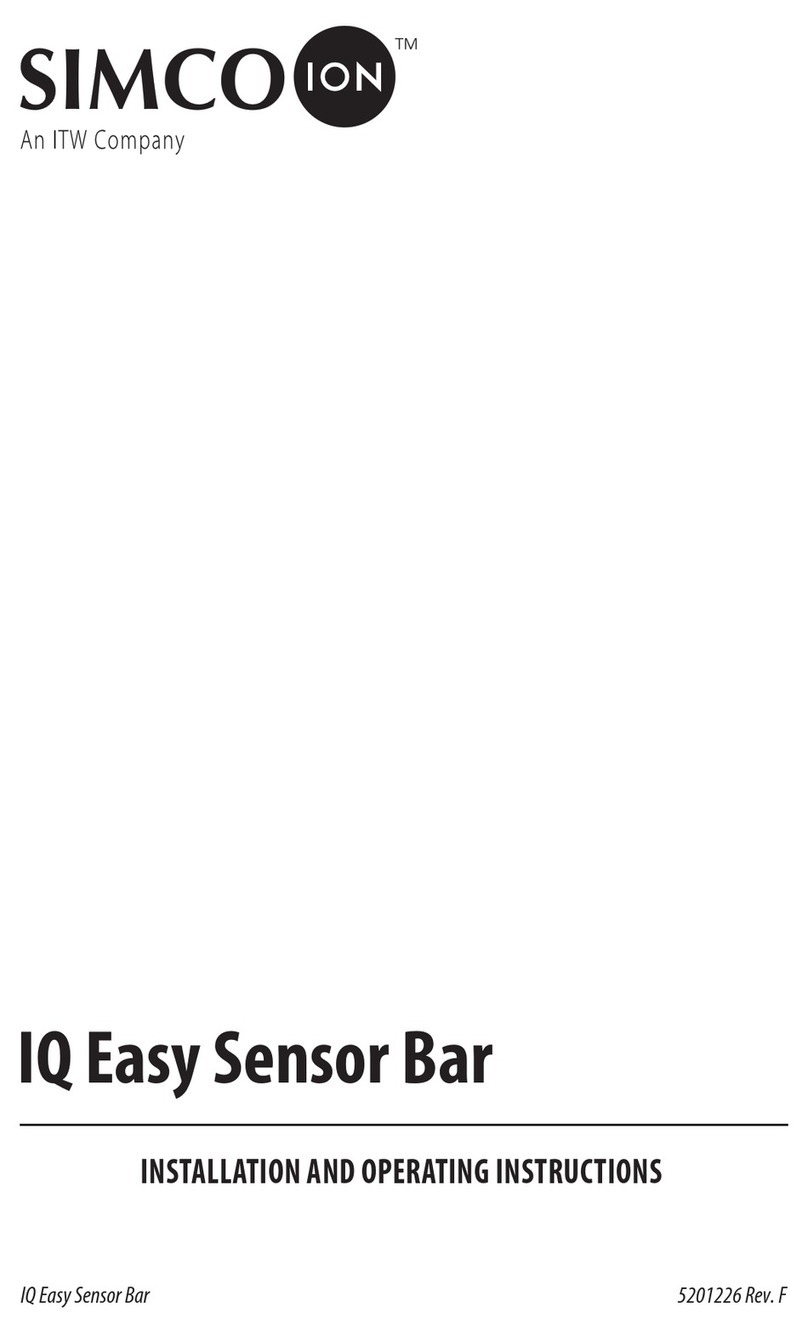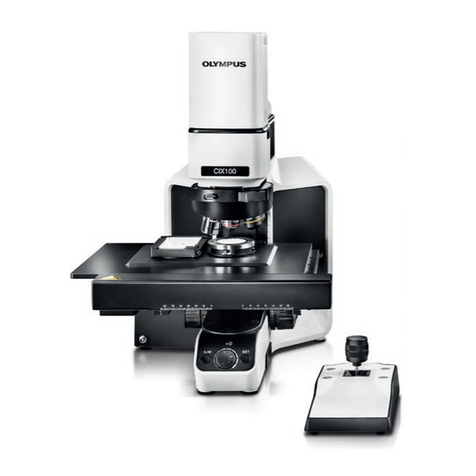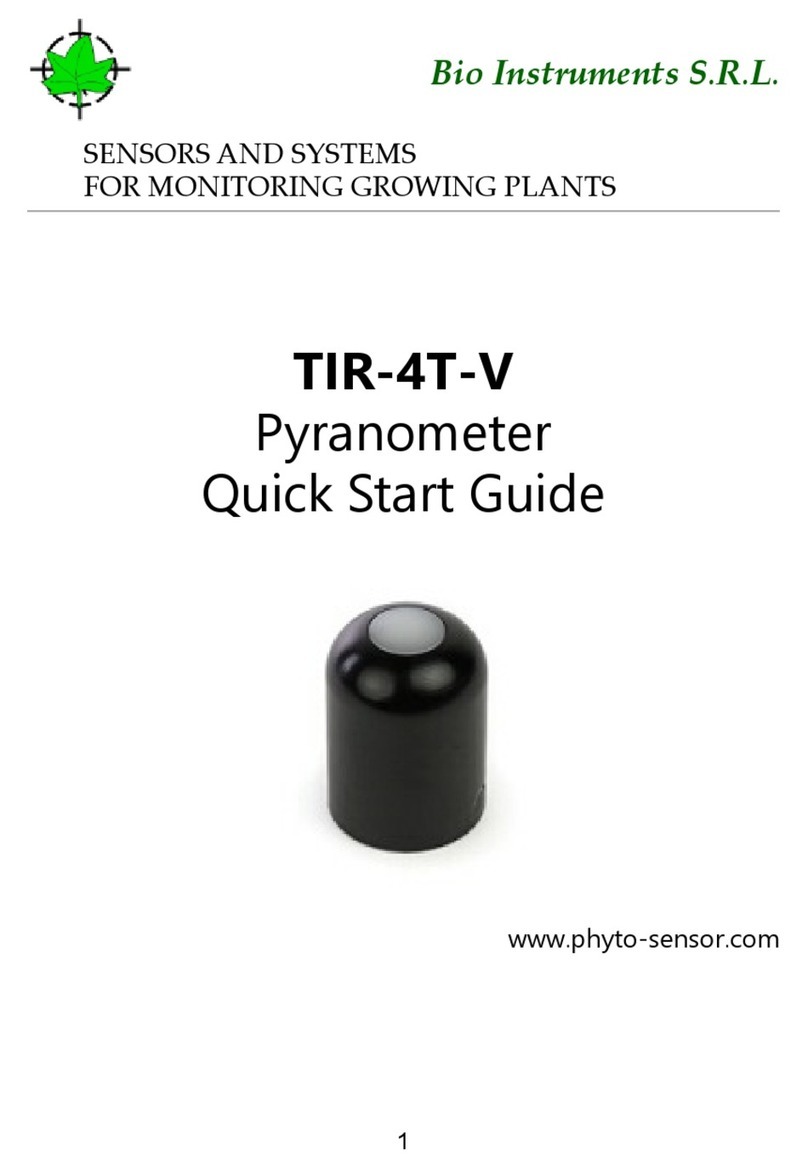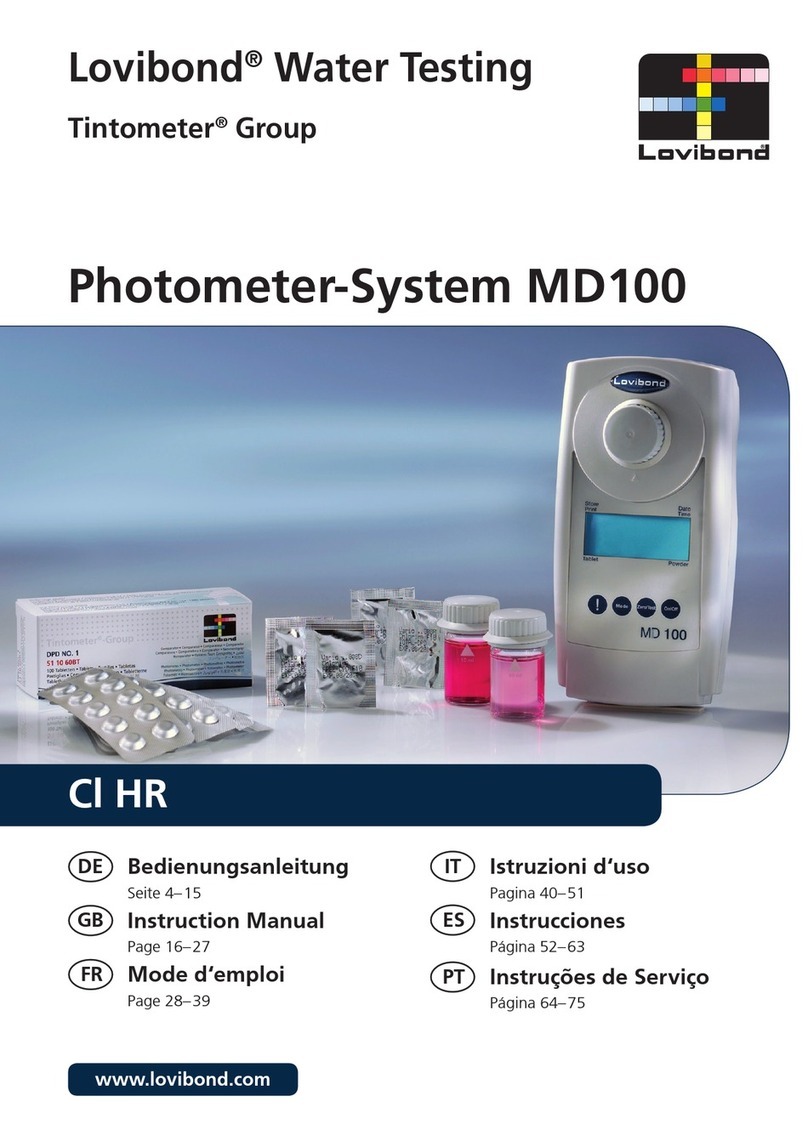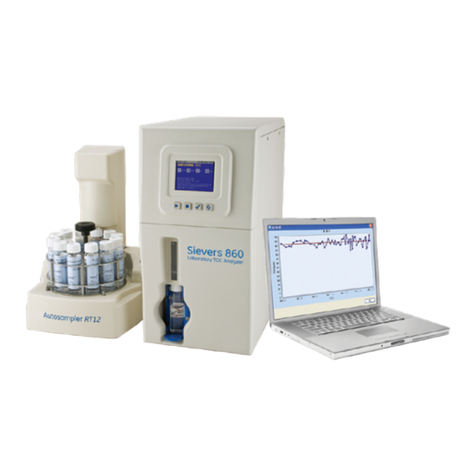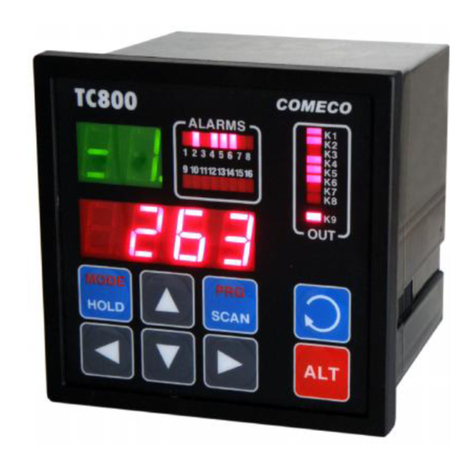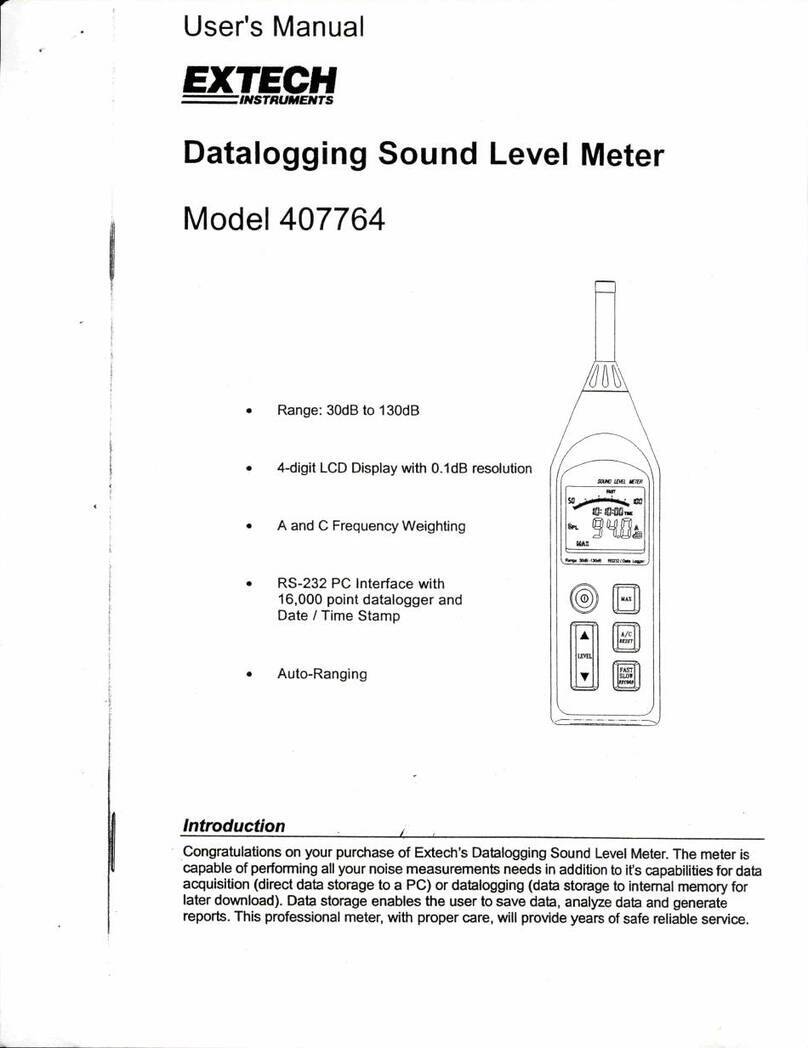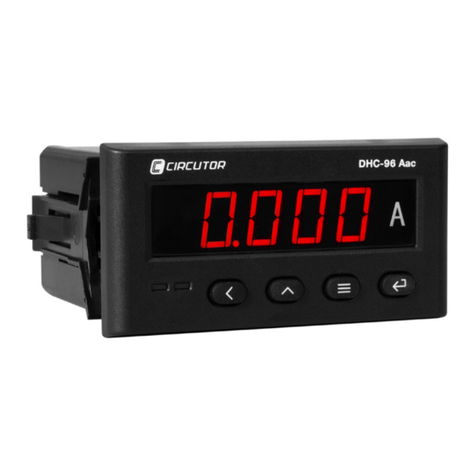Dexsil L2000DXT User manual


0
Copyright Notice
L2000DXT User's Manual and other documentation copyright © 1998, 2001, 2015, and 2018
Dexsil Corporation. All rights reserved.
Disclaimer
Dexsil Corporation makes no representations or warranties with respect to the contents hereof
and specifically disclaims any implied warranties of merchantability or fitness for any particular
purpose. Further, Dexsil Corporation reserves the right to revise this publication and to make
changes from time to time in the contents hereof without obligation of Dexsil Corporation to
notify any person of such revision or changes.
Trademarks
L2000 and Dexsil are trademarks of Dexsil Corporation.
DEXSIL CORPORATION
One Hamden Park Drive
Hamden, CT 06517
Tel (203) 288-3509
Fax (203) 248-6523
http://www.dexsil.com
Rev. 6, December 2018

1
Table of Contents
Introduction to the L2000DXT Analyzer .......................................................................2
Sample Preparation.................................................................................................2
Chloride Conversion Reaction................................................................................3
Quantification ........................................................................................................3
Unpacking............ ........................................................................................................4
List of Components.................................................................................................4
List of Reagent Options..........................................................................................5
Option 1 - 40 Oil Tests....................................................................................5
Option 2 - 20 Soil Tests .................................................................................5
Option 2a - 20 Soil Tests (Two-Step Procedure)..............................................5
Option 3 - 20 Water Tests...............................................................................6
Option 4 - 20 Wipe Tests................................................................................6
Initial Set Up........ ........................................................................................................7
Restoring the Electrode After Extended Storage..........................................................7
Basic Operation of the L2000DXT .................................................................................9
General Information......................................................................................................9
Navigating the Operating Program...............................................................................11
Main Menu..... ........................................................................................................11
Calibration...... ........................................................................................................12
Blank Determination...............................................................................................13
Analysis.......... ........................................................................................................15
Entering Header Information..................................................................................16
Creating or Editing a Method .................................................................................16
Data Management...................................................................................................18
Change Date or Time..............................................................................................20
Check Electrode......................................................................................................20
Sample Preparation. ........................................................................................................22
Oil Samples.......... ........................................................................................................22
Soil Samples......... ........................................................................................................22
Standard Procedure for Soil Analysis.....................................................................23
Two-Step Extraction Procedure for Soil Analysis..................................................24
Water Samples..... ........................................................................................................25
High Range (5-2000 ppm)......................................................................................25
Low Range (10 ppb - 5 ppm)..................................................................................25
Wipe Samples ...... ........................................................................................................26
Care and Maintenance .....................................................................................................27
General Care ........ ........................................................................................................27
Electrode Care and Maintenance..................................................................................28
Troubleshooting ....... ........................................................................................................28
Error Messages..... ........................................................................................................30
Appendix A: Additional Information Available from Dexsil .......................................33
Appendix B: Methods Table............................................................................................35
Appendix C: Technical Data............................................................................................37
Appendix D: Program Flow Chart..................................................................................38

2
Introduction to the L2000DXT Analysis System
Congratulations on your purchase of the L2000DXT Analyzer, a versatile analysis system suitable
for the analysis of a wide variety of chlorinated organic compounds in a variety of matrices. The
basic principal of the L2000DXT system is to measure the total organic chlorine content of a
sample and equate that to an equivalent concentration of the target or expected analyte. If all of
the organic chlorine present is assumed to be derived from the target analyte, then an upper limit
is established for the compound in question. (If other organic chlorines are present, in addition
to the target analyte, they will be counted as the target analyte.) To accomplish this, all of the
organically bound chlorine must be converted into inorganic chloride and the resulting chloride
quantified. Once the total chlorine content of the sample is known, a conversion factor is used to
convert the chloride concentration into an equivalent concentration of the target analyte. If the
contaminant is known, the resulting concentration estimates will accurately correlate with the
actual concentration of the analyte in the sample as determined by confirmatory analysis in the
lab. If the contaminant is unknown, a conservative or worst case conversion factor is chosen to
provide an upper limit for the concentration of the target analyte in the sample.
There are three basic steps involved in the chemical analysis for total halogen by the L2000DXT:
- Sample Preparation
- Conversion to Inorganic Chloride
- Quantification
The sample preparation step determines the type of chlorine detected, i.e., organic, inorganic, or
total, and is matrix dependent. The sample preparation can be as simple as collecting a
transformer oil sample, or can involve the extraction of a soil or water sample. In the case of a
wipe sample, the surface is wiped and the wipe-gauze is extracted. The steps involved in the
conversion to inorganic chloride reaction and the chloride quantification are the same for all
matrices. The steps in the conversion to inorganic chloride involve the reaction of the sample
with metallic sodium and the extraction of the resulting chloride into an aqueous buffer system.
A chloride specific electrode is used to quantify the extracted chloride. Using stored conversion
factors, the chloride value is then converted to an equivalent concentration of analyte.
Sample Preparation
The L2000DXT can be used to analyze the following matrices:
- Transformer Oil
- Soil
- Water
- Surface Wipe
Each matrix requires different preparation prior to the conversion reaction step and subsequent
quantification. Each of the matrix preparation steps are described in detail under Sample
Preparation.

3
The routine analysis of transformer oil requires no sample preparation other than to collect a
clean sample without introducing any extraneous sources of chloride into the sample, such as
perspiration or road salt. This is important because, for transformer oil, there is no sample
cleanup procedure to remove inorganic chloride contamination. Once collected, the sample is
reacted and the resulting chloride is extracted and quantified.
The chlorine quantified in this case is the total chlorine contained in the sample. Transformer oil
is typically free of inorganic chlorine, eliminating the need for any sample cleanup procedure. In
special cases where transformers have failed due to water contamination or have been removed
for service and stored in areas near seawater or road salt, inorganic chloride may cause an
elevated reading.
Before a soil sample can be analyzed, the organic contaminants must be extracted using an
organic solvent. Because soil samples invariably contain inorganic chlorine, the soil extract is
cleaned up to remove all traces of the inorganic chloride. The cleaned extract is then reacted and
the resulting chloride is quantified. For soil analyses, only the organic chlorine content is ever
quantified. Extraneous sources of chloride contamination such as road salt or sea salt are not
detected.
As with soil samples, a water sample must also be extracted prior to final analysis. The ratio of
the solvent volume to the sample volume determines the sensitivity of the test. The extract is
reacted and the chloride is quantified as above. In water samples, only the organic chlorine is
quantified.
Wipe tests require that a specific area be wiped using a hexane-soaked gauze. The gauze is
extracted with an organic solvent, reacted, and the chlorine content determined. For wipe
samples, the standard procedure eliminates most all inorganic chlorine contamination. Areas
with very high surface concentration of salts may need to be prepared differently.
Chloride Conversion Reaction
Once the sample has been prepared, the remaining chloride conversion steps are the same for all
sample types. The conversion step is a reaction of the sample with an excess of metallic sodium
in the presence of a catalyst to convert the covalently bound organic chlorine into free chloride
ions. This reaction of metallic sodium with organo-chlorine compounds is vigorous and goes to
completion, converting all of the organic chlorine to chloride.
Quantification
Upon the completion of the conversion reaction, the resulting chloride ions are extracted into an
aqueous buffer. The chloride content in the final extract/buffer is then quantified using a
chloride specific electrode and converted to an equivalent analyte concentration using the
conversion factors programmed into the chosen analysis method of the instrument. The
conversion factor is made up of the percent chlorine, the sample size multiplier, and the
extraction efficiency multiplier. The analyte concentration is determined by first subtracting the
blank from the raw chloride reading (except when the Blank Subtraction has been turned off),

4
and the resulting corrected chloride value is multiplied by the size and extraction multipliers and
divided by the chloride fraction (percent chlorine divided by 100):
[Analyte] = ([Cl-]raw - [Cl-]blank)(size multiplier)(extraction multiplier)/(chlorine fraction)
The L2000DXT Analyzer comes preprogrammed with 33 methods providing for analysis of a
large number of organo-chlorine compounds in most matrices. Correction factors are
preprogrammed to account for all of the steps necessary to run samples using the standard
prepackaged reagents. If the procedures are modified or other analytes are expected, up to 20
custom methods can easily be built.
The operational program of the L2000DXT has been designed to provide the most versatile data
reduction platform possible for the analysis of chlorinated organic compounds in a variety of
matrices. At the same time, the program is easy to use for routine analysis and does not require
custom method development.
Unpacking
The L2000DXT is shipped in its own carrying case, complete with all the hardware necessary for
operation. Upon receiving the L2000DXT Analyzer, please verify that all of the items listed
below are present and in good working order.
The carrying case for the L2000DXT Analyzer should contain the following items:
L2000DXT Electronic PCB/Chloride Analyzer
Power cube AC-DC transformer
Portable electronic balance & 100 g Calibration weight
5 mL pipettor
Vial rack
Timer
Marking pen
USB thumb drive
Two empty 20 mL glass vials for RINSE and CALIBRATION solutions
User’s Manual, Certificate of Calibration and MSDS
NOTE: DO NOT return meter to case with USB Drive installed.
In addition to the aforementioned items in the carrying case, the following should be included in
the same outer shipping box:
Chloride-ion specific electrode1
Packet of polishing strips1
Test tube rack
To prevent damage to the instrument in the case of a leak, the sample preparation reagents are
shipped separately. The exact makeup of the reagent pack will depend on the specific reagent
1These items are shipped in their original packaging from Orion. Once they have been unpacked, they should be carried in the right-hand slot in

5
option chosen at the time of ordering. The options available for the L2000DXT and the
components contained in each are the following:
Option 1: Reagents for 40 Oil Test
1 - 250 mL bottle of EXTRACT solution
1 - 250 mL bottle of RINSE solution
1 - 250 mL bottle of CALIBRATION solution
1 - 60 mL bottle of Electrode Filling Solution
1 - tray of 40 empty 20 mL glass vials
1 - box of tissue wipes
1 - shelf-pack containing (in a heat sealed foil bag):
40 - filters
40 - pipettes
40 - reaction tubes (black dispenser caps)
Reorder Part No: (LP-ORK)
Option 2: Reagents for 20 Soil Tests (Standard Procedure)
1 - 250 mL bottle of EXTRACT solution
1 - 250 mL bottle of RINSE solution
1 - 250 mL bottle of CALIBRATION solution
1 - 60 mL bottle of Electrode Filling Solution
1 - box of tissue wipes
1 - 40-cell box containing:
20 - empty 20 mL glass vials
20 - bottles containing Soil Extraction Solvent
1 - shelf-pack containing (in a heat sealed foil bag):
20 - filters
20 - pipettes
20 - reaction tubes (black dispenser caps)
20 - metal scoops for obtaining soil samples
20 - 10 mL plastic syringes
20 - drying columns (foil packed)
20 - empty test tubes with white caps
Reorder Part No: (LP-SRK)
Option 2a: Reagents for 20 Soil Tests (Two-Step Extraction Procedure)
1 - 250 mL bottle of EXTRACT solution
1 - 250 mL bottle of RINSE solution
1 - 250 mL bottle of CALIBRATION solution
1 - 60 mL bottle of Electrode Filling Solution
1 - box of tissue wipes
1 - set of instructions
1 - 40-cell box containing:
20 - empty 20 mL glass vials
20 - 6 mL black-capped water vials
1 - shelf-pack containing (in a heat sealed foil bag):

6
20 - empty 25 mL soil tubes
20 - filter funnels
20 - pipettes
20 - reaction tubes with black dispenser caps
20 - break-top vials containing Soil Extraction Solvent
20 - metal scoops for obtaining soil samples
20 - syringe filters (in a heat sealed foil bag)
1 - set of instructions
Reorder Part No: (LP-SR2)
Option 3: Reagents for 20 Water Tests
1 - 250 mL bottle of EXTRACT solution
1 - 250 mL bottle of RINSE solution
1 - 250 mL bottle of CALIBRATION solution
1 - 60 mL bottle of Electrode Filling Solution
1 - box of laboratory wipes
1 - 40-cell box containing:
20 - empty 20 mL glass vials
20 - bottles of Isooctane
1 - shelf-pack containing (in a heat sealed foil bag):
20 - filters
20 - pipettes
20 - reaction tubes (black dispenser caps)
20 empty test tubes with white caps
1 - set of instructions
Reorder Part No: (LP-WRK)
Option 4: Reagents for 20 Wipe Tests
1 - 250 mL bottle of EXTRACT solution
1 - 250 mL bottle of RINSE solution
1 - 250 mL bottle of CALIBRATION solution
1 - 60 mL bottle of Electrode Filling Solution
1 - box of tissue wipes
2 - pair of safety goggles (1 pair/10 tests)
2 - pair of neoprene gloves (1 pair/10 tests)
1 - shelf-pack containing (in a heat sealed foil bag):
20 - filters
20 - pipettes
20 - reaction tubes (black dispenser caps)
20 - hexane ampules
20 - empty test tubes with white dispensing caps
1 - box containing:
20 - gauze pads in 20 mL glass vials
20 - 10 mL glass bottles containing Extraction Solvent (isooctane)
1 - box containing:
20 - empty 20 mL glass vials

7
20 - forceps
1 - set of instructions
Reorder Part No: (LP-WIP)
NOTE: DO NOT STORE REAGENTS IN THE INSTRUMENT CARRYING CASE, AS ANY
LEAKS WILL DAMAGE THE INSTRUMENT.
Initial Set Up
Once the L2000DXT has been unpacked, the components checked and the contents of the reagent
pack verified, the L2000DXT can be set up for analysis. Locate the vial rack, the two empty 20
mL vials and the bottles of RINSE and CALIBRATION solutions. Remove the caps from both
vials and label one 20 mL vial “RINSE” and the other “CAL”. Fill each vial approximately ½
full with the appropriate solution and set in vial rack. (NOTE: It is helpful to label the rack with
the location of the RINSE and CAL vials.) These solutions will be used for the initial setup and
calibration of the electrode. They will also be used periodically to re-calibrate the electrode and
check the electrode output. Once set up, the electrode should remain in the RINSE solution
when not in use.
Prior to running the Analyzer on battery power, it should be charged overnight using the power
cube supplied with the instrument. The Analyzer can be operated from line power while the
battery is charging and should be left plugged in whenever AC power is available.
WARNING: STATIC ELECTRIC SHOCKS CAN DAMMAGE THE
ELECTRODE AND THE METER. DO NOT ATTACH ELECTRODE
WHEN METER IS ON.
Restoring the Electrode after Extended Storage
The electrode is shipped empty and should be stored empty whenever it will be left for an
extended period of time or placed in the carry case (see Electrode Care and Maintenance).
To restore the electrode to operating condition:
1. Remove protective cap from the tip of the electrode.
2. Fill the electrode, up to the filling hole in the side, with the Orion Electrode Filling
Solution supplied with each lot of reagents. To fill, place the nozzle of the fill
solution bottle into the hole on the side of the plastic body and gently squeeze the fill
bottle.
3. Drain the electrode, while holding it upright over the waste beaker, by grasping the
body of the electrode firmly in one hand and pushing down on the black cap where
the cord enters the electrode. The filling solution will drain out of the bottom of the
electrode.

8
4. Refill the electrode and make sure that the fill solution is making contact between the
black cone and the plastic shell at the bottom of the electrode. If it is not making
contact at all points, drain the electrode again and refill.
5. With the meter off, connect the electrode to the BNC connector labeled “Electrode”
on the back of the L2000DXT Analyzer and check electrode output.
6. To check the electrode, turn the Analyzer on by pressing the ON Button on the back
panel of the instrument. From the START SCREEN press ENTER to open the
MAIN MENU. At the MAIN MENU, press DIAG to open the DIAGNOSTICS
screen. This display:
will indicate the current system information and then continuously update the
electrode output in millivolts (mV). Place the electrode in fresh RINSE solution,
gently swirl the solution with the electrode and allow to equilibrate. The electrode
output should reach 140 mV or greater within 1 minute. If the electrode output does
not reach at least 140 mV by the time the 2 minute buzzer sounds, empty the RINSE
solution and refill with fresh RINSE solution. If this does not improve the electrode
output, drain the electrode, refill it with filling solution and check the output again.
NOTE: When setting up the L2000DXT after the unit and/or electrode has been in
storage or is brought from a colder/warmer environment, it is important to allow both
the unit and the electrode to equilibrate for as long as possible. It could take up to an
hour for the electrode to equilibrate. Once the output is greater than 140 mV, the
electrode is functioning correctly and it is safe to proceed with measurements. If the
electrode output does not reach 140 mV, see under Troubleshooting for remedies.
NOTE: The update rate for the DIAGNOSTICS screen is 10-20 seconds, any keys pressed will
not register until the end of the current measurement cycle. Therefore, to exit the
DIAGNOSTICS screen, the BACK button must be pressed until the meter registers the input.

9
Basic Operation of the L2000DXT
General Information
The L2000DXT meter is equipped with NiMh (Nickel Metal hydride) batteries and can be
operated with or without the wall adaptor. A fully charged battery should be sufficient to operate
for a full 8-hour day of sample analyses. To preserve the battery, the unit should be plugged into
an AC outlet whenever possible.
The operation of the L2000DXT is controlled by a program organized into a series of “screens”. A
screen prompts the user for appropriate input or displays output from the processor. There are
two screens at the beginning of the program that will be referred to throughout the text. They
are, the START SCREEN which appears when the analyzer is turned on and is returned to
when turning the meter off manually, and the MAIN MENU which is the next screen in
sequence. All of the functions of the meter can be accessed from the MAIN MENU.
From the MAIN MENU, the functions available are:
Header Management
Analysis
Choose a Method
Help
Data Management
Settings
Diagnostics
Header Management is used for adding or changing unique identifying information stored in
the header of each data file. Access to the main analysis loop for sample analysis is through the
Analysis button. Choose a Method is used to create, edit or select a new method. Pressing
Help will open the help screens. The Data Management option is used to export, review and
delete data stored in internal memory. Under Settings changes can be made to the time and
date. The temperature probe can be disabled from this screen. Diagnostics function is
available to check the functioning of the electrode.
Most screens will have, in addition to the information or choice specific to the screen, a BACK
button and an ENTER button. The BACK button will always bring the user back to the MAIN
MENU and the ENTER button will complete a screen’s transaction, saving any changes or
storing any choices and moving to the next screen in sequence. Other active buttons on a given
screen may redirect the program operation to other screens or may cause a “pop-up” screen to
appear requiring input. Where appropriate, some screens will display the current time, date, and
temperature.
Prior to turning the instrument on, the samples should be already prepared as described in
Sample Preparation and the extracts allowed to cool for 5 minutes.
To analyze a sample using a System Method from the method list, turn the unit on, press
ENTER to get to the MAIN MENU and then choose the Analysis button to enter the Analysis

10
Loop. Once in the loop, the program will prompt the user to chose a method, calibrate the
electrode, enter a blank and enter a sample ID. Samples can be analyzed without recalibration
for up to an hour or 20 samples whichever comes first. When appropriate, the program will
prompt for recalibration. (See below for a block diagram of the program.)
Once in the Analysis Loop, the Analyzer must be calibrated. The calibration procedure is a
single point calibration using a 50 ppm chloride CALIBRATION standard supplied with each
batch of reagents. This calibration must be repeated approximately every 20 measurements,
every hour or if the ambient temperature varies by more than 5°C, whichever comes first. A
counter, a timer, and a thermistor have been built into the instrument to prompt the user for
recalibration when necessary. During the calibration procedure, the function of the electrode
will also be evaluated. If the electrode potential for the calibration solution is not within the
acceptable limits (50 mV –75 mV), a warning will be displayed and the program will return to
the MAIN MENU. From the MAIN MENU choose DIAG to determine if the electrode is
working. (See below under Diagnostics.)
Following a successful calibration, the next step is to choose what type of blank to use.
Choosing to use the current blank will take the program directly to the SAMPLE ANALYSIS
screen. The meter is now ready to measure the prepared samples.
Each time the READ button is pressed, the program prompts for a new sample ID followed by a
prompt to place the electrode into the sample. Pressing READ from the prompt screen will
initiate the READ sequence. Once the electrode output has stabilized, the meter will display the
calculated result along with the relevant sample parameters. Further readings are initiated by
pressing the READ button and can be continued from this screen until the recalibration limits
have been reached.

11
Navigating the Operating Program
For an overview of the operating program see Appendix D
NOTE: Prior to turning the instrument on, the samples should be already prepared as described
in Sample Preparation and the extracts allowed to cool for 5 minutes.
Turn on the Analyzer by pressing the On Button on the back panel of the instrument. Press the
ON button only once, DO NOT HOLD. After a few seconds, the START SCREEN will then
open. Displayed on the START SCREEN should be the serial number of the unit along with
the software version number. If a USB drive is plugged in, the name of the data file on the drive
will be displayed, otherwise the message “No Device Found”will appear. The Analyzer is
ready to accept instructions. (If the battery voltage is below the safe limit, the message “Low
Battery” will appear and the unit will automatically shut off)
NOTE: If the unit does not turn on or the display flickers and turns off, the batteries may be too
low to use. Plug the unit in and wait a minute before proceeding with the unit plugged in.
From the START SCREEN press ENTER to open the MAIN MENU:

12
Once in the MAIN MENU, select the desired option to proceed. To begin sample analysis, using
the previously chosen Method, select Analysis to enter the Analysis Loop, either choice will
open the CHOOSE A METHOD screen:
Displayed on the screen, along with the current time, date and temp, will be the current method.
After verifying that the displayed method is the desired one, press ENTER to select it to move
on to the CALIBRATION screen.
Calibration
The first step required before any measurements can be made is to calibrate the electrode. The
program will jump to the CALIBRATION screen when a new method is selected, when the
temperature has changed by more than 5°C, or when the calibration timer or counter has
triggered. After placing the electrode in the CAL solution, press READ.
A progress timer will display then the final result indicating the mV reading of the electrode.

13
The acceptable values are 50 to 75 mV. If the reading is outside this range, the screen will
display a failure message:
Pressing BACK will return to the MAIN MENU screen. If the calibration voltage is acceptable,
the “pass” message will appear:
Pressing BACK will return to the MAIN MENU and ENTER will jump operation to the
BLANK INPUT screen.
Blank Determination
Once the electrode has been successfully calibrated, the meter is now ready to measure the
prepared samples. Pressing ENTER on the PASS screen will bring up the BLANK INPUT
screen:

14
To use the current stored blank (displayed in the box) simply press Use Current Blank. This
will keep the blank that is displayed and no further input is required before entering the
ANALYSIS LOOP. To measure a new blank solution or enter a new blank value from the
keypad, touch the New Blank button and the NEW BLANK screen will open with 2 choices for
entering a new blank.
Touching the Current Blank in Use button will open a numeric keypad for manual entry of the
desired blank. (NOTE: It is a good practice to periodically measure a “reagent” blank to keep
tabs on how the meter is working and to verify that the current lot of reagents is free of
extraneous chloride. Keep the blank readings handy and build a “running average” of the blank
for each lot of reagents and use it as the blank for measurements.)
Touching the Read New Blank button will open a prompt screen, at which time, put the
electrode in the freshly prepared and cooled reagent blank and press read. If the measured blank
is within the acceptable range, the program will proceed to the SAMPLE ANALYSIS screen
and the actual analysis can begin.

15
Pressing No Blank will set the current blank to zero and proceed to the SAMPLE ANALYSIS
screen.
Analysis
Prepare the samples for analysis as described under Sample Preparation. Once the
samples have been prepared and allowed to cool for at least 5 minutes, the method chosen, and
the meter calibrated (including any blank determination), analysis can begin. The SAMPLE
ANALYSIS screen will display instructions and options to complete the analysis. At this time,
check to see if the displayed information is correct for the header information, the method
chosen, and the blank in use.
Pressing the READ button from this screen will open the SAMPLE IDENTIFICATION screen
where a custom identifier can be added to each sample of up to 9 characters in length using the
pop-up alpha-numeric keypad. A three digit numeric extension will be added to the ID and will
automatically increment if the name is re-used without a change. Once the sample ID has been
entered, press ENTER to save the ID and begin measurement. NOTE: The meter will prompt
for the electrode to be placed in the sample before pressing READ. Pressing READ will begin
the read cycle, a progress bar will indicate how far along the convergence process is as a
percentage of the maximum 2 minutes allowed. Up to 20 samples can be analyzed before a
recalibration is required. Additionally, if the ambient temperature changes by more than 5°C or
if the one-hour timer expires, the program will prompt for a fresh calibration.
Remove the electrode from the rinse solution and wipe the body carefully with a tissue. NOTE:
DO NOT WIPE THE TIP OF THE ELECTRODE AS THIS MAY DAMAGE IT. Place the
electrode in the vial to be analyzed and swirl it gently for several seconds.

16
Without further stirring, press the READ button. The meter will take a series of readings. Once
the readings have converged on a constant value, the result will be displayed along with crucial
method information. A beeper will sound to indicate that the new value is ready.
To analyze additional samples, press the READ button. The program will check the ambient
temperature, the counter and the timer and, if they are still within the allowable ranges, the
program will begin the next analysis. Proceed as above to make the next measurement.
Samples may be saved for analysis at a later time, but the vials should be tightly capped. Once
they have been read, samples should be discarded. Do not re-analyze samples.
Pipettes and oil should be disposed of as PCB/Organo-chlorine waste. Analysis solution can be
disposed of as ordinary aqueous waste containing nickel.
Entering Header Information
There are 5 custom identifiers available in the header of the stored data file which can be up to
15 characters in length and are entered through the HEADER MANAGEMENT screen.
Touching any of the active boxes will open a pop-up alpha-numeric screen to enter the desired
header label. Once editing is complete, pressing ENTER will save the information and return
program operation to the MAIN MENU.
NOTE: There is no audible beep when pressing buttons in the pop-up alpha-numeric or
numeric screens.
Creating or Editing a Method
The key to the utility of the L2000DXT Analyzer is the versatility of the methods that can be
developed for the instrument. A “method” is the complete set of parameters that are necessary to
convert a chloride reading into an accurate quantification of the targeted analyte. Preprogramed
in the meter are a number of methods for the analysis of many common environmental

17
contaminants. These methods can be modified and custom methods can be built by setting any
of the conversion parameters used to convert the chloride reading into an equivalent analyte
concentration.
Each method requires 7 parameters to be set. These parameters are determined by the
composition of the sample and the chemistry of the sample preparation and/or extraction
procedures used to introduce the sample into the system. They can be either calculated from
known parameters or determined empirically from preliminary experiments. The parameters
common to all methods and their allowable ranges are tabulated below.
Parameter
Range of Values
Chlorine Content
10 - 100
Sample Size Correction
0.01 - 100
Extraction Efficiency Correction
0.01 - 100
Matrix
Oil, Soil, Water, Wipe
Units to be Displayed
ppm, mg/kg, ppb, ug/sdm
Analyte Label
15 character alpha-numeric
Method Name
15 character alpha-numeric
To create a new method or edit an existing method choose Edit/Create Method from the
CHOOSE A METHOD screen. The CREATE/EDIT METHOD screen will open:
Touching any of the active buttons displaying the current values for each parameter will open a
new screen. In the case of the percent chlorine, the size multiplier, or the extraction multiplier, a
pop-up numeric screen will open for entering the value of the selected conversion factor. In the
case of the matrix or the units, the new screen will display the available options. The options for
matrix are: Oil, soil, water and wipe. For units the options are: PPM, PPB, ug/100scm, or mg/kg.

18
To enter an analyte label a pop-up alpha-numeric data entry screen will open. NOTE: The
matrix, units and analyte parameters are merely labels that appear in the data files and on
the display; changing them will not affect the calculations or change the actual results.
Once all of the parameters have been edited, pressing either the Save New Method or the Save
and Analyze buttons will save the new method and exit to the next screen, either back to the
MAIN MENU or directly to the CALIBRATION screen respectively.
Data Management
The L2000DXT stores all data internally until it is deleted by the user. Data can also be
downloaded to a USB drive through the port in the back of the unit. To manage stored data,
select the Data Management option from the MAIN MENU. From the DATA
MANAGEMENT screen:
The options available are: Export Data, Review Data, and Delete Data. Choosing any of
these options will open further screens with detailed descriptions of the options and actions
required for the specific choice.
To export data, a USB drive must be plugged into the port on the back of the unit. Pressing
Export Data will download all of the data to a file on the drive beginning with “L_”followed by
2 digits representing, respectively, the current year, month and day as follows:
L_YYMMDD.CSV. The data file is in CSV (Comma Separated Values) format and can be read
by any text editing program or spreadsheet program. NOTE: DO NOT remove the USB drive
while the upload is in progress. This will cause a system error and cause the meter to reset.
The upload process may take several minutes.
If opened by Excel, the data should look something like:
Table of contents
Other Dexsil Measuring Instrument manuals
Popular Measuring Instrument manuals by other brands

Teledyne
Teledyne HASTINGS Everywhereyoulook 201 Series instruction manual
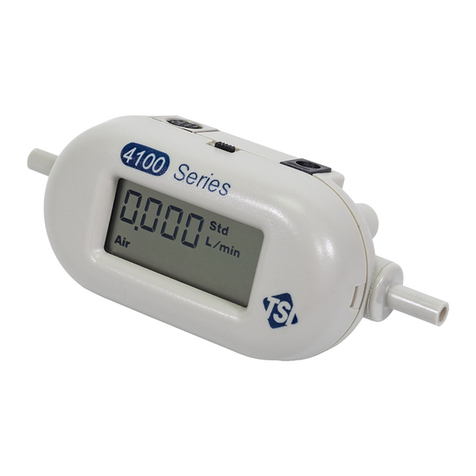
TSI Instruments
TSI Instruments 4199 Operation and service manual

PCE Health and Fitness
PCE Health and Fitness PCE-CT 80 user manual
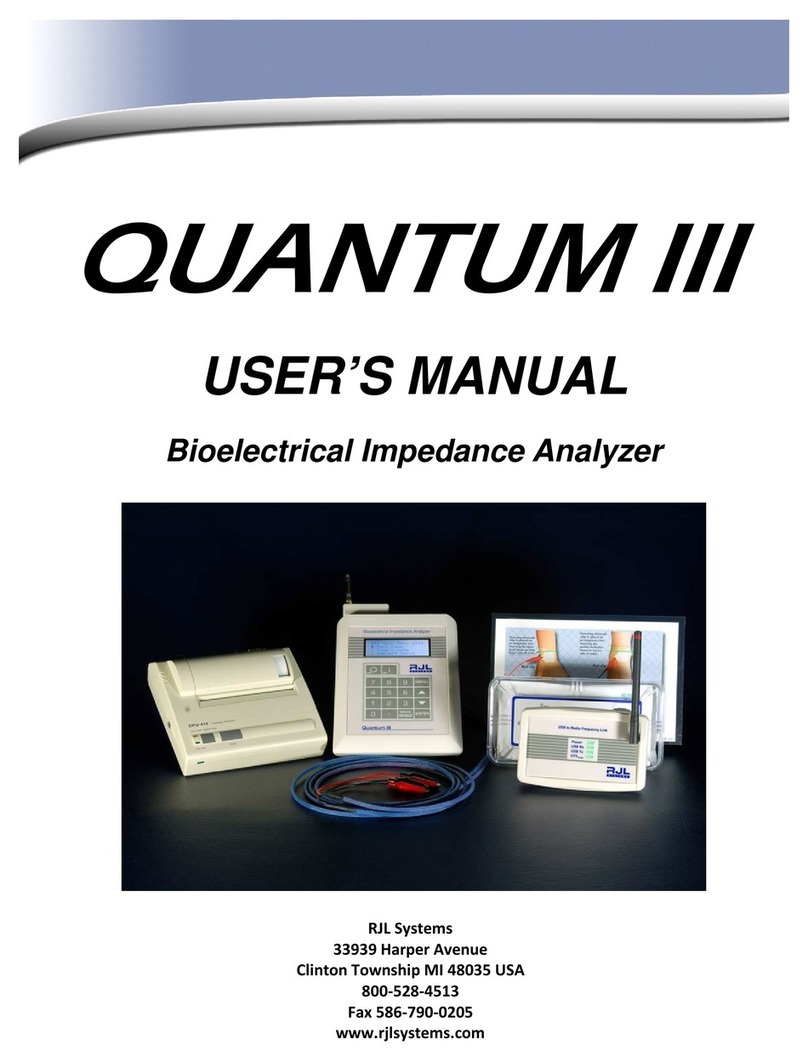
RJL systems
RJL systems QUANTUM III user manual
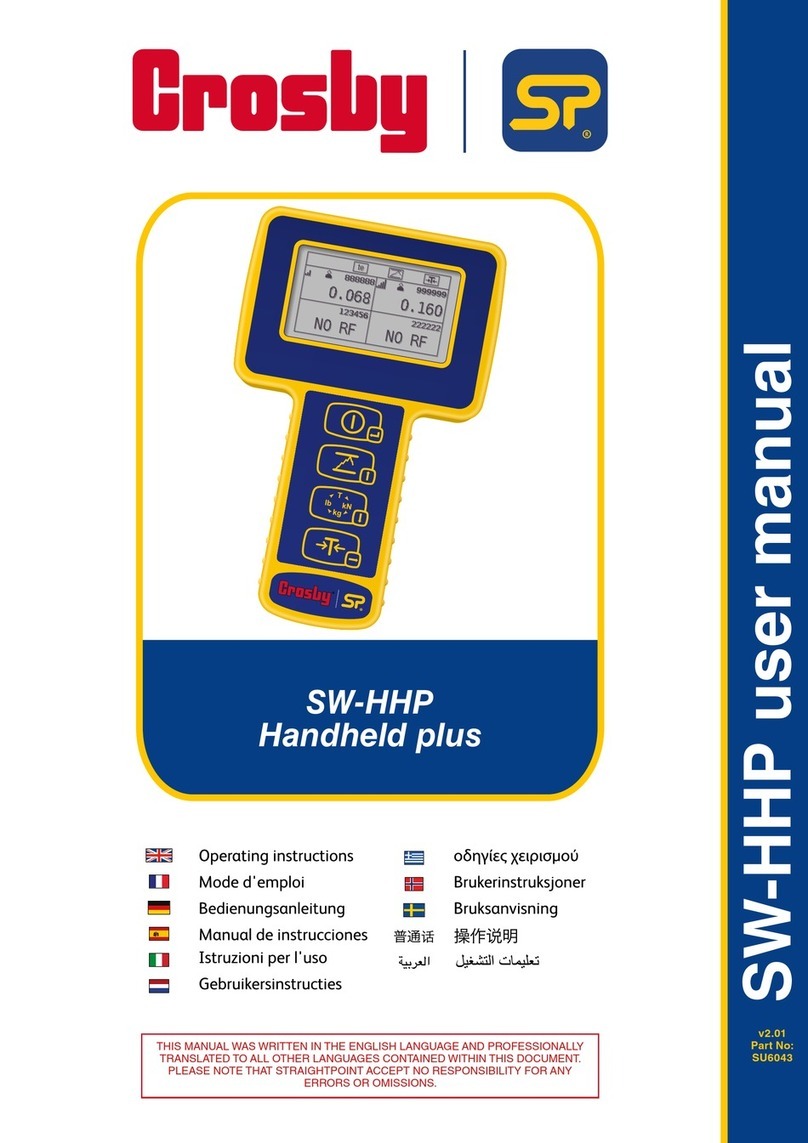
Crosby
Crosby SW-HHP Handheld plus operating instructions
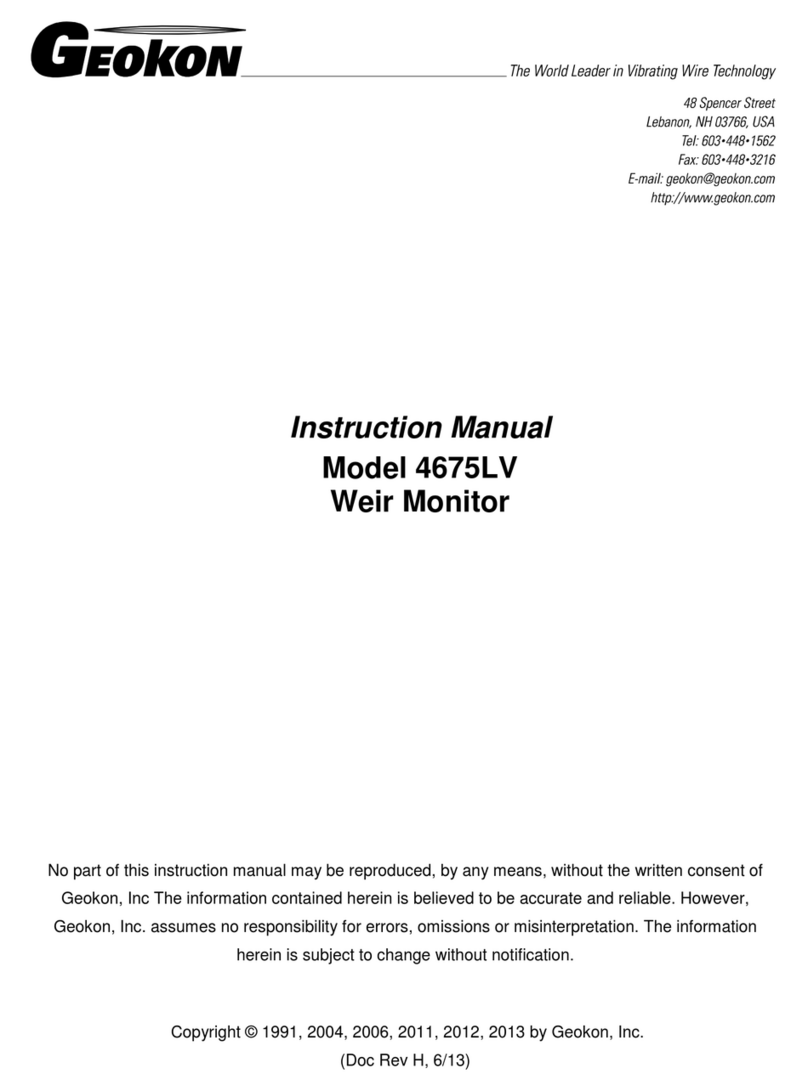
Geokon
Geokon 4675LV instruction manual


